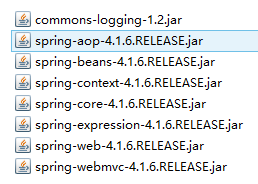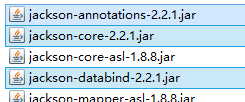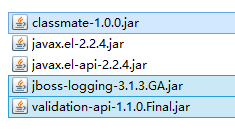1.首先,導入SpringMVC需要的jar包。

2.添加Web.xml配置文件中關於SpringMVC的配置
1 2 3 4 5 6 7 8 9 10 11 12 13 14 15<!--configure the setting of springmvcDispatcherServlet and configure the mapping-->
<servlet>
<servlet-name>springmvc</servlet-name>
<servlet-class>org.springframework.web.servlet.DispatcherServlet</servlet-class>
<init-param>
<param-name>contextConfigLocation</param-name>
<param-value>classpath:springmvc-servlet.xml</param-value>
</init-param>
<!-- <load-on-startup>1</load-on-startup> -->
</servlet>
<servlet-mapping>
<servlet-name>springmvc</servlet-name>
<url-pattern>/</url-pattern>
</servlet-mapping>
3.在src下添加springmvc-servlet.xml配置文件
1 2 3 4 5 6 7 8 9 10 11 12 13 14 15 16 17 18 19 20 21 22 23 24 25 26 27<?xml version="1.0" encoding="UTF-8"?>
<beans xmlns="http://www.springframework.org/schema/beans"
xmlns:xsi="http://www.w3.org/2001/XMLSchema-instance"
xmlns:context="http://www.springframework.org/schema/context"
xmlns:mvc="http://www.springframework.org/schema/mvc"
xsi:schemaLocation="http://www.springframework.org/schema/beans http://www.springframework.org/schema/beans/spring-beans.xsd
http://www.springframework.org/schema/context http://www.springframework.org/schema/context/spring-context-4.1.xsd
http://www.springframework.org/schema/mvc http://www.springframework.org/schema/mvc/spring-mvc-4.1.xsd">
<!-- scan the package and the sub package -->
<context:component-scan base-package="test.SpringMVC"/>
<!-- don't handle the static resource -->
<mvc:default-servlet-handler />
<!-- if you use annotation you must configure following setting -->
<mvc:annotation-driven />
<!-- configure the InternalResourceViewResolver -->
<bean class="org.springframework.web.servlet.view.InternalResourceViewResolver"
id="internalResourceViewResolver">
<!-- 前綴 -->
<property name="prefix" value="/WEB-INF/jsp/" />
<!-- 後綴 -->
<property name="suffix" value=".jsp" />
</bean>
</beans>
4.在WEB-INF文件夾下創建名為jsp的文件夾,用來存放jsp視圖。創建一個hello.jsp,在body中添加“Hello World”。
5.建立包及Controller,如下所示

6.編寫Controller代碼
1 2 3 4 5 6 7 8 9@Controller
@RequestMapping("/mvc")
public class mvcController {
@RequestMapping("/hello")
public String hello(){
return "hello";
}
}
7.啟動服務器,鍵入 http://localhost:8080/項目名/mvc/hello
1.Dispatcherservlet
DispatcherServlet是前置控制器,配置在web.xml文件中的。攔截匹配的請求,Servlet攔截匹配規則要自已定義,把攔截下來的請求,依據相應的規則分發到目標Controller來處理,是配置spring MVC的第一步。
2.InternalResourceViewResolver
視圖名稱解析器
3.以上出現的注解
@Controller 負責注冊一個bean 到spring 上下文中
@RequestMapping 注解為控制器指定可以處理哪些 URL 請求
@Controller
負責注冊一個bean 到spring 上下文中
@RequestMapping
注解為控制器指定可以處理哪些 URL 請求
@RequestBody
該注解用於讀取Request請求的body部分數據,使用系統默認配置的HttpMessageConverter進行解析,然後把相應的數據綁定 到要返回的對象上 ,再把HttpMessageConverter返回的對象數據綁定到 controller中方法的參數上
@ResponseBody
該注解用於將Controller的方法返回的對象,通過適當的HttpMessageConverter轉換為指定格式後,寫入到Response對象的body數據區
@ModelAttribute
在方法定義上使用 @ModelAttribute 注解:Spring MVC 在調用目標處理方法前,會先逐個調用在方法級上標注了@ModelAttribute 的方法
在方法的入參前使用 @ModelAttribute 注解:可以從隱含對象中獲取隱含的模型數據中獲取對象,再將請求參數 –綁定到對象中,再傳入入參將方法入參對象添加到模型中
@RequestParam
在處理方法入參處使用 @RequestParam 可以把請求參 數傳遞給請求方法
@PathVariable
綁定 URL 占位符到入參
@ExceptionHandler
注解到方法上,出現異常時會執行該方法
@ControllerAdvice
使一個Contoller成為全局的異常處理類,類中用@ExceptionHandler方法注解的方法可以處理所有Controller發生的異常
//match automatically
@RequestMapping("/person")
public String toPerson(String name,double age){
System.out.println(name+" "+age);
return "hello";
}
1.編寫一個Person實體類
1 2 3 4 5 6 7 8 9 10 11 12 13 14 15 16 17 18 19package test.SpringMVC.model;
public class Person {
public String getName() {
return name;
}
public void setName(String name) {
this.name = name;
}
public int getAge() {
return age;
}
public void setAge(int age) {
this.age = age;
}
private String name;
private int age;
}
2.在Controller裡編寫方法
1 2 3 4 5 6//boxing automatically
@RequestMapping("/person1")
public String toPerson(Person p){
System.out.println(p.getName()+" "+p.getAge());
return "hello";
}
//the parameter was converted in initBinder
@RequestMapping("/date")
public String date(Date date){
System.out.println(date);
return "hello";
}
//At the time of initialization,convert the type "String" to type "date"
@InitBinder
public void initBinder(ServletRequestDataBinder binder){
binder.registerCustomEditor(Date.class, new CustomDateEditor(new SimpleDateFormat("yyyy-MM-dd"),
true));
}
//pass the parameters to front-end
@RequestMapping("/show")
public String showPerson(Map<String,Object> map){
Person p =new Person();
map.put("p", p);
p.setAge(20);
p.setName("jayjay");
return "show";
}
前台可在Request域中取到"p"
//pass the parameters to front-end using ajax
@RequestMapping("/getPerson")
public void getPerson(String name,PrintWriter pw){
pw.write("hello,"+name);
}
@RequestMapping("/name")
public String sayHello(){
return "name";
}
前台用下面的Jquery代碼調用
1 2 3 4 5 6 7$(function(){
$("#btn").click(function(){
$.post("mvc/getPerson",{name:$("#name").val()},function(data){
alert(data);
});
});
});
//redirect
@RequestMapping("/redirect")
public String redirect(){
return "redirect:hello";
}
1.需要導入兩個jar包

2.在SpringMVC配置文件中加入
1 2 3 4<!-- upload settings -->
<bean id="multipartResolver" class="org.springframework.web.multipart.commons.CommonsMultipartResolver">
<property name="maxUploadSize" value="102400000"></property>
</bean>
3.方法代碼
1 2 3 4 5 6 7 8 9 10 11 12 13 14@RequestMapping(value="/upload",method=RequestMethod.POST)
public String upload(HttpServletRequest req) throws Exception{
MultipartHttpServletRequest mreq = (MultipartHttpServletRequest)req;
MultipartFile file = mreq.getFile("file");
String fileName = file.getOriginalFilename();
SimpleDateFormat sdf = new SimpleDateFormat("yyyyMMddHHmmss");
FileOutputStream fos = new FileOutputStream(req.getSession().getServletContext().getRealPath("/")+
"upload/"+sdf.format(new Date())+fileName.substring(fileName.lastIndexOf('.')));
fos.write(file.getBytes());
fos.flush();
fos.close();
return "hello";
}
4.前台form表單
1 2 3 4<form action="mvc/upload" method="post" enctype="multipart/form-data">
<input type="file" name="file"><br>
<input type="submit" value="submit">
</form>
@Controller
@RequestMapping("/test")
public class mvcController1 {
@RequestMapping(value="/param")
public String testRequestParam(@RequestParam(value="id") Integer id,
@RequestParam(value="name")String name){
System.out.println(id+" "+name);
return "/hello";
}
}
1.RestController
1 2 3 4 5 6 7 8 9 10 11 12 13 14 15 16 17 18 19 20 21 22 23 24 25 26 27 28@Controller
@RequestMapping("/rest")
public class RestController {
@RequestMapping(value="/user/{id}",method=RequestMethod.GET)
public String get(@PathVariable("id") Integer id){
System.out.println("get"+id);
return "/hello";
}
@RequestMapping(value="/user/{id}",method=RequestMethod.POST)
public String post(@PathVariable("id") Integer id){
System.out.println("post"+id);
return "/hello";
}
@RequestMapping(value="/user/{id}",method=RequestMethod.PUT)
public String put(@PathVariable("id") Integer id){
System.out.println("put"+id);
return "/hello";
}
@RequestMapping(value="/user/{id}",method=RequestMethod.DELETE)
public String delete(@PathVariable("id") Integer id){
System.out.println("delete"+id);
return "/hello";
}
}
2.form表單發送put和delete請求
在web.xml中配置
1 2 3 4 5 6 7 8 9<!-- configure the HiddenHttpMethodFilter,convert the post method to put or delete -->
<filter>
<filter-name>HiddenHttpMethodFilter</filter-name>
<filter-class>org.springframework.web.filter.HiddenHttpMethodFilter</filter-class>
</filter>
<filter-mapping>
<filter-name>HiddenHttpMethodFilter</filter-name>
<url-pattern>/*</url-pattern>
</filter-mapping>
在前台可以用以下代碼產生請求
1 2 3 4 5 6 7 8 9 10 11 12 13 14 15 16 17<form action="rest/user/1" method="post">
<input type="hidden" name="_method" value="PUT">
<input type="submit" value="put">
</form>
<form action="rest/user/1" method="post">
<input type="submit" value="post">
</form>
<form action="rest/user/1" method="get">
<input type="submit" value="get">
</form>
<form action="rest/user/1" method="post">
<input type="hidden" name="_method" value="DELETE">
<input type="submit" value="delete">
</form>
1.導入以下jar包

2.方法代碼
1 2 3 4 5 6 7 8 9 10 11 12 13 14@Controller
@RequestMapping("/json")
public class jsonController {
@ResponseBody
@RequestMapping("/user")
public User get(){
User u = new User();
u.setId(1);
u.setName("jayjay");
u.setBirth(new Date());
return u;
}
}
1.處理局部異常(Controller內)
1 2 3 4 5 6 7 8 9 10 11 12 13@ExceptionHandler
public ModelAndView exceptionHandler(Exception ex){
ModelAndView mv = new ModelAndView("error");
mv.addObject("exception", ex);
System.out.println("in testExceptionHandler");
return mv;
}
@RequestMapping("/error")
public String error(){
int i = 5/0;
return "hello";
}
2.處理全局異常(所有Controller)
1 2 3 4 5 6 7 8 9 10@ControllerAdvice
public class testControllerAdvice {
@ExceptionHandler
public ModelAndView exceptionHandler(Exception ex){
ModelAndView mv = new ModelAndView("error");
mv.addObject("exception", ex);
System.out.println("in testControllerAdvice");
return mv;
}
}
3.另一種處理全局異常的方法
在SpringMVC配置文件中配置
1 2 3 4 5 6 7 8<!-- configure SimpleMappingExceptionResolver -->
<bean class="org.springframework.web.servlet.handler.SimpleMappingExceptionResolver">
<property name="exceptionMappings">
<props>
<prop key="java.lang.ArithmeticException">error</prop>
</props>
</property>
</bean>
error是出錯頁面
1.創建一個MyInterceptor類,並實現HandlerInterceptor接口
1 2 3 4 5 6 7 8 9 10 11 12 13 14 15 16 17 18 19 20 21 22 23public class MyInterceptor implements HandlerInterceptor {
@Override
public void afterCompletion(HttpServletRequest arg0,
HttpServletResponse arg1, Object arg2, Exception arg3)
throws Exception {
System.out.println("afterCompletion");
}
@Override
public void postHandle(HttpServletRequest arg0, HttpServletResponse arg1,
Object arg2, ModelAndView arg3) throws Exception {
System.out.println("postHandle");
}
@Override
public boolean preHandle(HttpServletRequest arg0, HttpServletResponse arg1,
Object arg2) throws Exception {
System.out.println("preHandle");
return true;
}
}
2.在SpringMVC的配置文件中配置
1 2 3 4 5 6 7<!-- interceptor setting -->
<mvc:interceptors>
<mvc:interceptor>
<mvc:mapping path="/mvc/**"/>
<bean class="test.SpringMVC.Interceptor.MyInterceptor"></bean>
</mvc:interceptor>
</mvc:interceptors>
3.攔截器執行順序
十六、表單的驗證(使用Hibernate-validate)及國際化
1.導入Hibernate-validate需要的jar包

(未選中不用導入)

2.編寫實體類User並加上驗證注解
1 2 3 4 5 6 7 8 9 10 11 12 13 14 15 16 17 18 19 20 21 22 23 24 25 26 27 28 29 30 31public class User {
public int getId() {
return id;
}
public void setId(int id) {
this.id = id;
}
public String getName() {
return name;
}
public void setName(String name) {
this.name = name;
}
public Date getBirth() {
return birth;
}
public void setBirth(Date birth) {
this.birth = birth;
}
@Override
public String toString() {
return "User [id=" + id + ", name=" + name + ", birth=" + birth + "]";
}
private int id;
@NotEmpty
private String name;
@Past
@DateTimeFormat(pattern="yyyy-MM-dd")
private Date birth;
}
ps:@Past表示時間必須是一個過去值
3.在jsp中使用SpringMVC的form表單
1 2 3 4 5 6<form:form action="form/add" method="post" modelAttribute="user">
id:<form:input path="id"/><form:errors path="id"/><br>
name:<form:input path="name"/><form:errors path="name"/><br>
birth:<form:input path="birth"/><form:errors path="birth"/>
<input type="submit" value="submit">
</form:form>
ps:path對應name
4.Controller中代碼
1 2 3 4 5 6 7 8 9 10 11 12 13 14 15 16 17@Controller
@RequestMapping("/form")
public class formController {
@RequestMapping(value="/add",method=RequestMethod.POST)
public String add(@Valid User u,BindingResult br){
if(br.getErrorCount()>0){
return "addUser";
}
return "showUser";
}
@RequestMapping(value="/add",method=RequestMethod.GET)
public String add(Map<String,Object> map){
map.put("user",new User());
return "addUser";
}
}
ps:
1.因為jsp中使用了modelAttribute屬性,所以必須在request域中有一個"user".
2.@Valid 表示按照在實體上標記的注解驗證參數
3.返回到原頁面錯誤信息回回顯,表單也會回顯
5.錯誤信息自定義
在src目錄下添加locale.properties
NotEmpty.user.name=name can't not be empty Past.user.birth=birth should be a past value DateTimeFormat.user.birth=the format of input is wrong typeMismatch.user.birth=the format of input is wrong typeMismatch.user.id=the format of input is wrong
在SpringMVC配置文件中配置
1 2 3 4<!-- configure the locale resource -->
<bean id="messageSource" class="org.springframework.context.support.ResourceBundleMessageSource">
<property name="basename" value="locale"></property>
</bean>
6.國際化顯示
在src下添加locale_zh_CN.properties
username=賬號 password=密碼
locale.properties中添加
username=user name password=password
創建一個locale.jsp
1 2 3 4<body>
<fmt:message key="username"></fmt:message>
<fmt:message key="password"></fmt:message>
</body>
在SpringMVC中配置
1 2<!-- make the jsp page can be visited -->
<mvc:view-controller path="/locale" view-name="locale"/>
讓locale.jsp在WEB-INF下也能直接訪問
最後,訪問locale.jsp,切換浏覽器語言,能看到賬號和密碼的語言也切換了
1.創建一個test.SpringMVC.integrate的包用來演示整合,並創建各類

2.User實體類
1 2 3 4 5 6 7 8 9 10 11 12 13 14 15 16 17 18 19 20 21 22 23 24 25 26 27 28 29 30 31public class User {
public int getId() {
return id;
}
public void setId(int id) {
this.id = id;
}
public String getName() {
return name;
}
public void setName(String name) {
this.name = name;
}
public Date getBirth() {
return birth;
}
public void setBirth(Date birth) {
this.birth = birth;
}
@Override
public String toString() {
return "User [id=" + id + ", name=" + name + ", birth=" + birth + "]";
}
private int id;
@NotEmpty
private String name;
@Past
@DateTimeFormat(pattern="yyyy-MM-dd")
private Date birth;
}
3.UserService類
1 2 3 4 5 6 7 8 9 10@Component
public class UserService {
public UserService(){
System.out.println("UserService Constructor...\n\n\n\n\n\n");
}
public void save(){
System.out.println("save");
}
}
4.UserController
1 2 3 4 5 6 7 8 9 10 11 12 13@Controller
@RequestMapping("/integrate")
public class UserController {
@Autowired
private UserService userService;
@RequestMapping("/user")
public String saveUser(@RequestBody @ModelAttribute User u){
System.out.println(u);
userService.save();
return "hello";
}
}
5.Spring配置文件
在src目錄下創建SpringIOC的配置文件applicationContext.xml
1 2 3 4 5 6 7 8 9 10 11 12 13 14 15 16 17 18 19 20 21 22<?xml version="1.0" encoding="UTF-8"?>
<beans xmlns="http://www.springframework.org/schema/beans"
xmlns:xsi="http://www.w3.org/2001/XMLSchema-instance"
xsi:schemaLocation="http://www.springframework.org/schema/beans
http://www.springframework.org/schema/beans/spring-beans.xsd
http://www.springframework.org/schema/util
http://www.springframework.org/schema/util/spring-util-4.0.xsd
http://www.springframework.org/schema/context
http://www.springframework.org/schema/context/spring-context.xsd
"
xmlns:util="http://www.springframework.org/schema/util"
xmlns:p="http://www.springframework.org/schema/p"
xmlns:context="http://www.springframework.org/schema/context"
>
<context:component-scan base-package="test.SpringMVC.integrate">
<context:exclude-filter type="annotation"
expression="org.springframework.stereotype.Controller"/>
<context:exclude-filter type="annotation"
expression="org.springframework.web.bind.annotation.ControllerAdvice"/>
</context:component-scan>
</beans>
在Web.xml中添加配置
1 2 3 4 5 6 7 8<!-- configure the springIOC -->
<listener>
<listener-class>org.springframework.web.context.ContextLoaderListener</listener-class>
</listener>
<context-param>
<param-name>contextConfigLocation</param-name>
<param-value>classpath:applicationContext.xml</param-value>
</context-param>
6.在SpringMVC中進行一些配置,防止SpringMVC和SpringIOC對同一個對象的管理重合
1 2 3 4 5 6 7<!-- scan the package and the sub package -->
<context:component-scan base-package="test.SpringMVC.integrate">
<context:include-filter type="annotation"
expression="org.springframework.stereotype.Controller"/>
<context:include-filter type="annotation"
expression="org.springframework.web.bind.annotation.ControllerAdvice"/>
</context:component-scan>
十九、SpringMVC與struts2的區別
1、springmvc基於方法開發的,struts2基於類開發的。springmvc將url和controller裡的方法映射。映射成功後 springmvc生成一個Handler對象,對象中只包括了一個method。方法執行結束,形參數據銷毀。springmvc的 controller開發類似web service開發。
2、springmvc可以進行單例開發,並且建議使用單例開發,struts2通過類的成員變量接收參數,無法使用單例,只能使用多例。
3、經過實際測試,struts2速度慢,在於使用struts標簽,如果使用struts建議使用jstl。